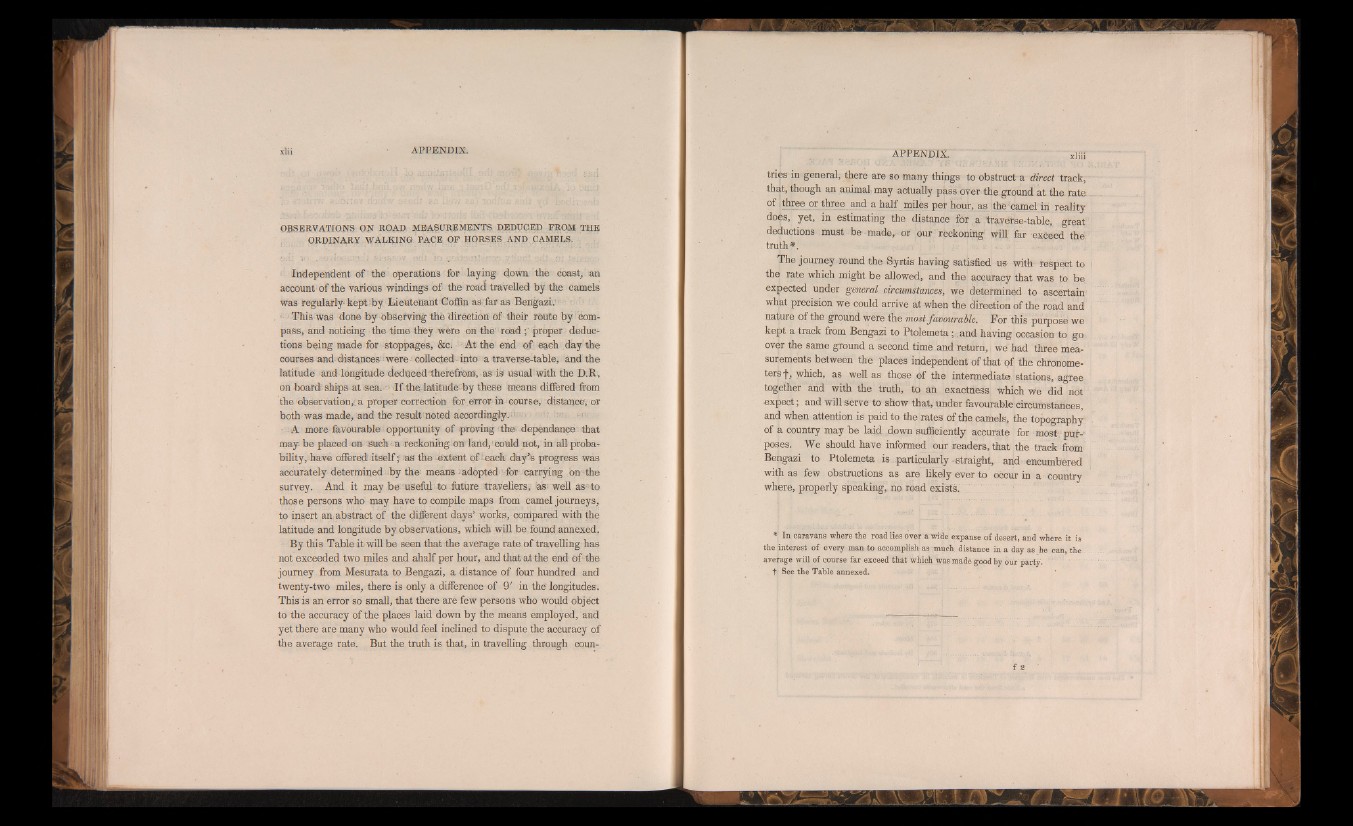
OBSERVATIONS ON ROAD MEASUREMENTS DEDUCED FROM THE
ORDINARY WALKING PACE OF HORSES AND CAMELS. '
< Independent Of the operations fcr laying down the coast, an
account of the various windings of the road travelled by the camels
was regularly kept foy lie u te n a n t Goffin as far as Bengazi. ■
- This was done by-observing thè direction of their route by compassi
and noticing the time they were on thè' road ; proper deductions
being made for stoppages, ficci A t th e end 0f: each day the
courses and-distances ; were collected-into a tiaverse-table, ànd the
latitude and longitude deduced therefrom, as isi usual with the D.R,
on board ships at-sea. I f the; latitude by these means differed from
the observation,; a proper correction for error in course,1 distance, or
both w a s made, and the result noted accordingly,;' ■-
- A more favourable opportunity of proving th e dependence that
m a y b e placed on Such a reckoning on'land,'couldnot, in allprobability,
have offered itself ; ¡as the-extent of ; each day’s progress was
accurately determined -by th e means ¡ad o p ted 1 for-carrying bnnthe
survey. And it may be.-¡usefulto future travellers,-as; well às<-to
those persons who may have to compile maps from camel journeys,
to insert an abstract o f the different days’ works, coinpared with the
latitude and longitude b y observations, which will be found annexed.
By this Table i t will be seen that the average rate Of travelling has
not exceeded two miles and ahalf per hour, and that at the end Of- the
journey from Mesurata to Bengazi, a distance of four hundred and
twenty-two miles, there is only a difference of 9 ' in the" longitudes.
This is an error so small, that there are few persons who would object
to the accuracy of the places laid down by the means employed, and
y e t there are many who would feel inclined to dispute the accuracy of
the average rate. But the truth is that, in travelling through countries
in general, there are so many things to obstruct a direct track,
that, though an animal may actually pass over the grpund a t th e ra te
of -three or three arid a half miles per hour, as the camel in reality
does, yet, in estimating the distance for a traverse-table, great
deductions must be made, or our reckoning will' far exceed the.
truth*.
The journey round the Syrtis having satisfied' us with respect to
the rate which might be allowed, and the accuracy that was to be
expected under general circumstances, we determined to ascertain
what precision we could arrive at when the direction of the road and
nature of the ground were the most favourable. For this purpose we
kept a track from Bengazi to Ptolemeta; .and having occasion to go.
over the same ground a second time and return, we had three measurements
between the places independent of that of the chronometers
f , which, as well as those of the intermediate stations, agree
together and with the truth, to an exactness which we did not
e x p e c t; and will serve to show that, under favourable circumstances,
and when attention is paid to the rates of the. camels, the topography
of a country may b e laid down sufficiently accurate for -most-purposes.
We should have informed our readers, that the track from
BeUgazi to Ptolemeta is particularly-straight, and encumbered
with as few obstructions as are likely ever to occur in a Country
where, properly speaking, no road exists.
* In caravans where the road lies over a wide expanse of desert, and where it is
the interest of every man to accomplish as much distance in a day as he can, the
avefage will of course far exceed that which was made good hy our party.
, +; See the Table annexed.